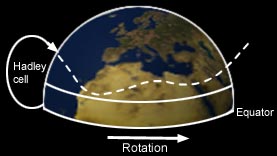Atmosphere Contents
5. General Circulation
There are cellular circulations of air in each hemisphere near the equator, known as Hadley Cells
As equatorial air rises, air from low altitude in the horse latitudes moves toward the equator to take its place. However, due to the Coriolis force, this flow is deflected causing the air to blow from the northeast in the Northern Hemisphere and from the southeast in the Southern Hemisphere. These steady winds are called the trade winds. Near the equator, the northeast trades converge with the southeast trades along the boundary called the intertropical convergence zone (ITCZ). This region is characterised by heavy precipitation in convective thunderstorms, and by relatively low surface pressures. There is strong upward motion of the returning surface air in this zone as it continues its cellular journey, known as the Hadley circulation, with each hemisphere having its own circulation cell, a Hadley cell. Until recently, it was thought that the tropical trade winds were separated by a region of calm winds called the 'doldrums' but it now seems that the transition occurs a few degrees north of the equator, in the very narrow ITCZ belt.

What are Hadley cells?